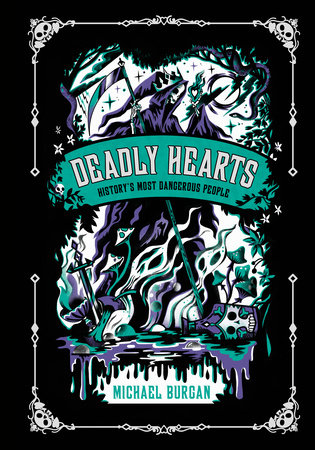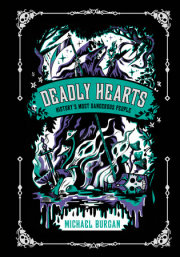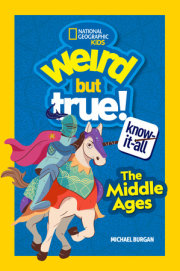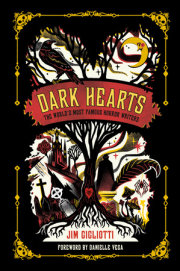Introduction
His body tied to a wooden rack, a man screams and begs for his life. Spanish soldiers tighten the ropes attached to his arms and legs. They stretch the man’s body until he confesses to a crime he didn’t commit—or until he dies.
In another part of Europe, wooden poles stick out of the ground, their tops sharpened to points. Just below one point, a body lies limp. With the pole piercing his body, the victim dies a slow death.
In Africa, piles of severed hands surround a military officer from Belgium. The soldiers under his command cut the hands from the bodies of rebels they kill, to prove they have not wasted any bullets. One hand means one bullet fired.
These gruesome scenes could have come from a horror movie. But they all actually happened. The deeds described here were carried out under the orders of ruthless people whose actions reflect the evil that humans are capable of.
Over centuries and around the world, there have been leaders with great power who have used cruelty and violence to get what they wanted. Some sought to conquer other lands so they could build great empires and amass personal wealth. Other leaders wanted to squash any threats to their rule from rebels or outside enemies. A few may have been driven by a touch of madness. Some people believed their god, or gods, had chosen them to rule and had given them a divine right to kill in the name of their religions. And some, for reasons that are hard for most people to understand, simply enjoyed seeing others suffer.
Collected here are the stories of sixteen men and women, powerful people with deadly hearts. What forces shaped them? Some lived when violence and cruelty seemed to be just a part of life—and rulers were expected to get what they wanted. Others believed that mass killing was an acceptable way to take revenge in response to harm done to them or their people.
Whatever their background or the world they faced, these sixteen people remind us that human nature has a dark side that can be unleashed in truly terrible ways. Their stories demonstrate that there is a long history of ruthless people who have wreaked havoc to get what they want. They might also say something about us, the people who are drawn to read about their horrible deeds. Do we read them to try to understand how some people can become so evil? Or perhaps to learn lessons we’d like to never see repeated?
Whether empire building or simply displaying a cruel streak, is there any excuse for the actions of people who have been responsible for the deaths of so many? And can we, as a society, prevent the rise of new “deadly hearts”? Or will the impulse for evil in some people always find a way out?
Alexander the Great (356 BCE–323 BCE)
Royal rulers can often trace their family histories back to many kings. Alexander the Great made an even bolder claim: that through his father, his roots went back to the ancient Greek hero Heracles (often known as Hercules today). He, in turn, was the son of the most powerful of all the Greek gods, Zeus. On his mother’s side, Alexander’s family tree included the famous Greek warrior Achilles. Alexander did not deny stories that said his true father was the god Zeus himself!
With that background, it’s no wonder that Alexander the Great believed he was meant to accomplish great things. And he did—during his short life, he created one of the largest empires the world has ever seen. But along with skillfully commanding his troops, Alexander often showed a cruel and ruthless side.
His real father was not a god but King Philip II. Philip laid the foundation for Alexander’s military success. As the king of Macedonia, one of several independent states located in what is now the nation of Greece, Philip expanded his country’s army and made his soldiers professionals who pledged their loyalty to him. The Macedonians valued bravery on the battlefield, and the sons of noble families began training for military careers when they were fourteen years old.
Starting during the 350s BCE, Philip used his army to conquer Greek lands south of Macedonia and unite them under his rule. He was off fighting in 356 BCE when Alexander was born in the Macedonian capital of Pella. The young prince quickly showed that he had a sharp mind, and as a teenager he left Pella to study with the great Greek philosopher Aristotle. One of the books Alexander read was the Iliad. It told the tales of Greek warriors in ancient times, and Alexander thought it was a very good guide on how to wage war against a nation’s enemies. The book also showed Alexander that revenge could be a powerful force in world affairs. In the Iliad, a great war starts when the Greeks seek to retaliate against the city of Troy.
Revenge also drove Achilles, one of those warriors who is mentioned in the Iliad. After the death of one of his friends, Achilles sought out and killed the Trojan who had killed him.
Alexander’s own mother, Olympias, may have led him to believe that Achilles was a distant relative of theirs. Alexander knew he was expected to follow in the footsteps of Achilles and other heroic soldiers of the past. Olympias may have also fed Alexander’s belief that he was related to the gods—an idea that would have made him think he could do what he pleased when he became king.
Alexander also had a military role model close at hand—his father. Philip’s wars against Greek cities continued as Alexander grew up. The boy once told friends that he was afraid his father would achieve so many victories, there would be nothing left for Alexander to do to show his greatness.
Although he had limited training in actual combat, Alexander commanded cavalry (soldiers on horseback) for his father when he was eighteen. But not all the violence Alexander experienced came on the battlefield. In 336 BCE, King Philip II was killed by a friend. It was said that Alexander’s mother may have encouraged the murder, as she wanted her son Alexander to rule Macedonia in Philip’s place.
The violence surrounding the royal family continued after Philip’s death. To guarantee that he would become king, Alexander killed at least one of his own half brothers and others who might oppose his rule. Then, one of Philip’s generals threw his support to Alexander, ensuring that he would take the throne. At the time, he was just twenty years old.
The Greek city of Thebes rebelled against the young king. Alexander took brutal revenge. One ancient historian noted that by the end of the fighting, “every corner of the city was piled high with corpses.” Then Alexander carried off the city’s children and enslaved them.
Once Alexander had full control of Greece, he led his army eastward. His target: Persia, at the time the largest empire in the world. The Persians had earlier invaded Greece and destroyed the city of Athens. As ruler of a united Greece, Alexander wanted revenge. Defeating the Persians would also bring him great wealth and glory.
In 334 BCE, Alexander and his army began their march through Persian lands, including what is now Turkey, Egypt, and Israel. The site of one of Alexander’s worst acts of cruelty was in Tyre, an island city off the coast of Lebanon. To build a road over the water to attack the city, Alexander destroyed homes so that he could use their stone and wood. When the fighting was over, Alexander killed the city’s rulers as well as thousands of soldiers who had survived the battle.
By 330 BCE, Alexander had reached the Persian capital of Persepolis. Persian troops were on the way to defend the city, but Alexander got there first. He let his men run wild through Persepolis, robbing and killing civilians. Alexander then burned the city’s palaces.
After conquering the heart of Persia, Alexander continued to head east. His army fought and won in what is now Afghanistan, Uzbekistan, Tajikistan, and Pakistan. Their march of conquest finally ended in India. Along the way, Alexander captured and destroyed dozens of cities. As in Tyre, he often killed surrendering soldiers. Many civilians died in the fighting as well. Alexander was known for savage bouts of anger, which he directed at his enemies. When one Persian governor refused to accept his authority, Alexander had him tied to the back of a chariot and dragged through the city.
Some of his anger and the resulting violence might have been fueled by alcohol, as Alexander was a heavy drinker. After one night of drinking, he argued with Cleitus, one of his top generals, and drove a spear through Cleitus’s chest. And Alexander killed others close to him if he suspected he was losing their loyalty.
At times, the Macedonian king may have used the sudden bursts of violence to frighten his enemies. But his cruel streak suggested that some of his behavior was not part of a grand military plan. At one battle, his enemy hired some seven thousand soldiers to fight the Greeks. After Alexander won, he agreed to let these hired soldiers be released. But then he changed his mind and had them all killed.
By 326 BCE, after being away for almost ten years, Alexander’s men wanted to return home, and he agreed. But the great conqueror would not see Pella again. He died in 323 BCE in what is now Iraq. Some people at the time thought he might have been poisoned. Modern theories suggest he could have died from alcoholism or another disease.
To some, Alexander was a great leader because of his military successes. He also spread Greek culture to parts of Asia, where his influence is still felt. Some boys are still named Iskander, an Arab version of “Alexander.” And at least one figure from Greek myth, Heracles, appears in Buddhist writings. But in his drive to build his vast empire, and at times take revenge on others, Alexander also killed tens of thousands of innocent people.
Julius Caesar (100 BCE–44 BCE) A famous quote from ancient Rome is still sometimes repeated today:
Veni vidi vici. That Latin phrase means “I came, I saw, I conquered,” and its author was Julius Caesar, a Roman general and political leader. His dream was to rule all of Rome, and he hoped his military victories would ensure his fame and win support of the Romans. His victories, though, came at the cost of many innocent lives.
From a tiny village along Italy’s Tiber River, Rome grew to become a powerful military force. By the time Gaius Julius Caesar was born in 100 BCE, Rome controlled all of Italy and parts of Spain, France, Greece, North Africa, and Turkey.
For Roman generals, victory in foreign lands meant praise back in Rome. The most successful generals used their popularity—and the wealth they won from conquering others—to gain political power, in addition to the military power they already had. Julius Caesar followed that path after his successful battles in Gaul. That region included most of France and parts of Belgium and other nearby countries. Gaul is also where Caesar earned his reputation as a ruthless killer, slaughtering hundreds of thousands of people.
But who was Caesar? His family said they could trace their roots to Aeneas, an ancient Roman hero. Though Caesar belonged to the ruling class of Romans, he did not have great wealth. He did, however, have intelligence, a talent for public speaking, and a knack for making friends with rich and powerful Romans.
During Caesar’s youth, Rome faced trouble from within and from outside forces. In Italy, Romans fought a civil war over who should rule. In what is now Turkey, enemy forces invaded land in the region under Roman control.
During the civil war, several of Caesar’s relatives were killed. While still a teen, he faced the possibility of death himself. His name was on a list of people who were considered enemies of Sulla, Rome’s dictator during the early 80s BCE. The people who ended up on his enemies list could lose their property—or their lives. For a time, Caesar had to flee Rome to save his life. The warfare and political battles within Rome may have convinced the young Caesar that his country needed a strong ruler to survive.
Like many Roman men who were of noble backgrounds but had little money, Caesar joined the army. He showed great skill on the battlefield. Thanks to his political connections, he won several government positions, and in 61 BCE he went to Spain to serve as its governor. He led troops against Spanish tribes who were resisting Roman rule. During his time as governor there, Caesar amassed great wealth, and he used some of his money to pay his soldiers. With that and his military talents, he won their loyalty.
He also won the support of some of the poorer people of Rome. When he was in the city, he spent money on public entertainment. He also spoke out at times against the wealthy men who controlled Roman politics. Like Alexander the Great before him, Caesar claimed to have family ties to the gods. He was paving the way for others to see him as a great man bound to rule.
By 59 BCE, Caesar’s power was certainly on the rise. He shared control of the Roman government with two other men, Pompey and Crassus. He governed several Roman provinces, or territories, including the part of Gaul west of the Alps. Most of the land was not under direct Roman control. Caesar seized on the chance to extend Roman rule through conquest. That, he knew, would only increase his influence in Rome.
Caesar started what are known as the Gallic Wars in 58 BCE. His first target was a tribe called the Helvetians. Commanding an army of up to thirty thousand men, he pursued them across the Saône River in what is now eastern France. Most of the Helvetians made it across the river before Caesar’s troops reached them, but about a quarter did not. The Helvetians included women and children, and Caesar attacked them along with the soldiers. The women and children tried to defend themselves, but as a Roman historian noted, they “were cut to pieces with the men.”
The fighting in Gaul went on for almost a decade, with Caesar also venturing into Britain and lands along the Rhine River. The Gauls, on the whole, were familiar with warfare and could be brutal themselves. Their warriors sometimes hung the severed heads of their enemies on their doorways! But the slaughter Caesar carried out in Gaul was on a huge scale.
Fighting German tribes along the Rhine and Meuse Rivers, Caesar ordered his men to chase and kill fleeing women and children. The German soldiers saw this and realized they would be attacked, so they retreated, but they could not escape the Romans. Caesar’s men killed about four hundred thousand people during this single battle.
Caesar was also responsible for what we know today as genocide. That means the mass killing of people of one ethnic or racial background. Caesar’s act of genocide came against the Eburones. This tribe from northeastern Gaul had earlier carried out a successful sneak attack against Caesar’s troops. In 53 BCE, Caesar took his revenge, sending fifty thousand troops to attack the Eburones, a slaughter that Caesar claimed wiped out the Eburones forever.
Caesar’s war in Gaul ended in 50 BCE. Historians estimate that his men killed up to one million people in the region, including women and children. In Rome, Caesar won praise for extending Rome’s rule. But some leading Romans thought he had gone too far with his massacres of civilians.
Caesar, though, was not done. In 49 BCE, he marched his troops back to Rome, starting a bloody civil war that would lead to his becoming Rome’s sole leader. His rule, though, didn’t last. Some Roman lawmakers opposed his ruling as a dictator. On March 15, 44 BCE, a group of them attacked Caesar and stabbed him to death.
The young Caesar had been shaped by the violence all around him. Instead of turning away from it, he embraced it. Mass slaughter of foreigners and killing his own people gave him the power he craved. But in the end, he died by the same violence that had marked his life. And he set Rome on a new path—future leaders would rule as emperors, following his example of one-man rule over a growing empire.
Copyright © 2022 by Penguin Random House LLC.. All rights reserved. No part of this excerpt may be reproduced or reprinted without permission in writing from the publisher.

















